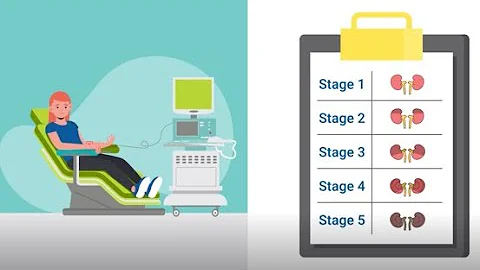"Doctor, I have been taking this medicine for a while, but my urine is still red, and there is no sign of improvement at all."
"In your case, it is recommended to perform a renal biopsy examination to make it clear. After the pathological type, the treatment plan can be better optimized. "
" Other are not uncomfortable. Is it necessary to undergo surgery? "
" Yes, the specific cause of hematuria is not clear. , it is necessary to conduct this auxiliary examination to accurately grasp the condition "
" How can I hear others say that not only is the pain unbearable, but the harm after the operation may be greater than the original disease. What about ? "
Regarding this question raised by the patient, it cannot be said that it is completely incorrect, but according to the current medical level, the incidence of is already very low. Moreover, renal biopsy is the "gold standard" for diagnosing kidney disease, which can provide a good basis for the pathogenesis of kidney disease, clarifying the cause, guiding treatment and judging prognosis.

Ultrasound-guided renal puncture biopsy Renal puncture biopsy - high success rate and few complications
Renal puncture biopsy is now performed, usually under ultrasound guidance. Compared with manual puncture after ultrasound positioning, it has a higher success rate and fewer complications.
Some scholars have conducted research and found that the success rate of ultrasound-guided percutaneous renal puncture biopsy in patients with kidney disease can reach 100.00%, which is significantly higher than the 87.50% achieved by manual puncture with ultrasound positioning.
In addition, patients with this method did not experience complications during the operation, and only a few patients experienced waist discomfort after the operation. The incidence of complications was 5%, which was also significantly reduced compared to the control group. (Reference source: "Clinical Research on the Diagnosis of Kidney Disease by Ultrasound Percutaneous Renal Biopsy")

It is not surprising that such research results appear. After all, the operation is performed under ultrasound guidance, regardless of the direction of the needle insertion, or the depth of the puncture , it is all visualized . Moreover, under this condition, the puncture speed is accelerated, and sufficient kidney tissue specimens can be obtained in a short time. shortens the residence time of the puncture needle in the body .
Also, under ultrasound guidance, it can avoid blood vessels well, reducing the risk of postoperative bleeding.
In short, the operation of kidney biopsy has been well optimized, and the preoperative preparations will naturally not be left behind. Preoperative anesthesia is a key point that cannot be ignored. The quality of anesthesia will also interfere with subsequent operations to a certain extent.

Propofol combined with ketamine for general anesthesia is rarely used!
The traditional propofol combined with ketamine general anesthesia has been largely replaced. Now the commonly used one is dexmedetomidine combined with ketamine general anesthesia.
The sedative effect of propofol is very strong , and it mainly works by inhibiting the cerebral cortex and limbic system. And to a certain extent, it affects the way ketamine blocks the pathway between , thalamus, , and cortex, and at the same time affects the activation of the limbic system, playing a synergistic sedative effect.
However, the efficacy of propofol in analgesia is unsatisfactory, and ketamine has limited improvement in visceral pain produced when penetrating renal capsule and other renal tissues.
Therefore, when the dosage of the two is insufficient, it is easy for body movement reaction to occur due to pain, which is not only detrimental to specimen collection, but also causes increased damage to the kidneys.

Propofol and ketamine also have short effects, so patients wake up quickly. After waking up, due to pain at the puncture site, discomfort in prone position, and activation of the limbic system by ketamine, patients are prone to hallucinations, agitation, delirium and other adverse mental reactions.
In addition, using propofol combined with ketamine for general anesthesia operation requires close attention to the patient's respiratory function.Although the commonly used dose of ketamine has a slight impact on breathing, propofol has a significant respiratory inhibitory effect. In addition, the patient needs to remain in the prone position, and it is easy for symptoms of abnormal breathing to occur.

But after replacing dexmedetomidine with propofol , these problems were solved. First of all, dexmedetomidine is as sedative as propofol. It is a highly selective and efficient α2 adrenergic receptor agonist drug. It works by stimulating presynaptic membrane α2 receptors in the locus coeruleus. body, producing a sedative and hypnotic effect.
has a good analgesic (suppression of acute visceral pain) effect of , mainly through α2 receptors acting on the postsynaptic membrane of presynaptic neurons and interneurons in the spinal dorsal horn.
and combined with ketamine can bring the analgesic and hypnotic effects of ketamine to a higher level and achieve a synergistic effect.

The long-lasting sedative-hypnotic effect produced by dexmedetomidine is similar to physiological sleep and is easy to wake up. However, the analgesic effect of along with the sedative effect will persist in , which helps the patient maintain the prone position and reduces the occurrence of body movement reactions.
In addition, dexmedetomidine has little effect on the patient's respiratory function . On the one hand, it has little impact on the axis diameters of the upper respiratory tract, and the risk of respiratory obstruction is small; on the other hand, it has no significant impact on respiratory frequency and tidal volume.

Complications are rare, but they cannot be ignored.
Although with the advancement of medical technology, such as the improvement of anesthetic drugs and more visual operations, complications still cannot be ignored. The few occurrences do not mean that there is no possibility of complications.
Common complications include: hematuria, perinephric hematoma, low back pain, etc. . In fact, most of these complications are related to postoperative bleeding.
The occurrence of postoperative bleeding is affected by many factors. First of all, the amount of bleeding is related to the renal blood supply of patients. Patients with rich intrarenal blood vessels are more likely to have bleeding.

Secondly, it is related to the depth of puncture . If the depth of puncture is too deep, the greater the risk of bleeding. When it reaches renal medulla , it may cause penetrating damage to the kidneys.
The number of punctures has nothing to do with . After all, this examination is an invasive operation and will cause certain damage to the kidneys. When the number of punctures increases, the damage will only be greater.
Furthermore, patients with poor kidney function are more likely to bleed after undergoing this examination. Because patients with renal failure have more phenols, guanidines and other small molecule toxins in their bodies, affects the normal physiological functions of platelets , inhibits the activity of coagulation factors , and the result of the combined effect is to increase the patient's bleeding. The probability.

In addition, hypertension is also an independent factor for bleeding after renal biopsy. Long-term high blood pressure may cause hyalinization, endomysial thickening and other pathological changes in the renal arterioles.
Once the renal arterioles become diseased, the blood flow supplied to the kidneys will be reduced, resulting in corresponding ischemic damage in glomeruli and renal tubules , which can ultimately lead to renal tubular atrophy and interstitial fibrosis . When performing a kidney biopsy, complications such as postoperative bleeding are common.

Who needs percutaneous renal biopsy?
After reading this, everyone must have a new understanding of kidney biopsy. At this stage, this examination is not only less painful, but also does not cause much harm after the operation. Percutaneous renal biopsy is recommended for patients with the following kidney diseases.
Some glomerular diseases patients, such as asymptomatic hematuria, asymptomatic proteinuria, primary nephrotic syndrome and acute nephritic syndrome with sharp decline in renal function, hereditary familial Patients with glomerular disease need to undergo kidney biopsy to clarify the pathological type of the disease and adjust the treatment plan.
In addition, it is suspected to be secondary nephropathy, such as lupus nephritis, diabetic nephropathy, renal amyloidosis, etc.; acute kidney injurypatients with unknown etiology or delayed renal function recovery; these two In order to determine the cause of the disease, a kidney biopsy is usually required.

Note that some patients with kidney disease have passed kidney biopsy and been treated for a period of time, but when the treatment plan is not effective, they also need to undergo kidney biopsy. Since the pathological manifestations of some kidney diseases will change during the development and treatment process, performing renal biopsy again is of great significance for judging the treatment effect, disease prognosis and adjusting the treatment plan.
However, not all patients with kidney disease need to undergo renal puncture biopsy. Patients with high blood pressure and obvious bleeding tendencies will increase the risk of postoperative bleeding. Renal puncture biopsy is generally not recommended.
Patients with solitary kidney and renal insufficiency should also be carefully considered, because there is only one kidney. Once serious complications occur, it will have a huge impact on the quality of life of subsequent patients.

is written at the end
When facing traumatic auxiliary examinations, you cannot rely solely on subjective judgment. In many cases, it is not as scary as you think.
Like the percutaneous renal biopsy mentioned today, with the upgrade of anesthetic drugs (especially analgesia) and more visual operation, the safety of the examination is higher, and the patient's discomfort has also been significantly reduced.
References:
[1] Zhou Dawei, Zheng Li, Liang Fadong, Zhu Zhengtao, Chen Jie. Risk factors for severe bleeding after ultrasound-guided percutaneous renal biopsy [J]. Imaging Science and Photochemistry, 2022, 40(02):357-361.
【2】Liang Junming, Jiang Zebo, Deng Jianguo, Mo Qiuxia, Li Ziwei. Analysis of complications and risk factors of ultrasound-guided percutaneous renal biopsy[J]. Mathematical Medicine Journal of Science , 2020, 33(03):330-332.
【3】Li Qiang, Hu Huakun, Xiao Yu, Shen Shihui, Fu Huan, Ye Lingling. Dexmedetomidine combined with ketamine is used for percutaneous renal biopsy in children The effect of surgery [J]. Journal of Clinical Anesthesiology , 2019, 35(05): 432-435.
[4] Lin Jie, Zhou Guoyong, Wu Yandan, Wu Lijun, Jiang Zebo. Ultrasound percutaneous renal biopsy in the diagnosis of kidneys Clinical research on diseases[J].Shenzhen Journal of Integrated Traditional Chinese and Western Medicine,2021,31(14):74-75.





















